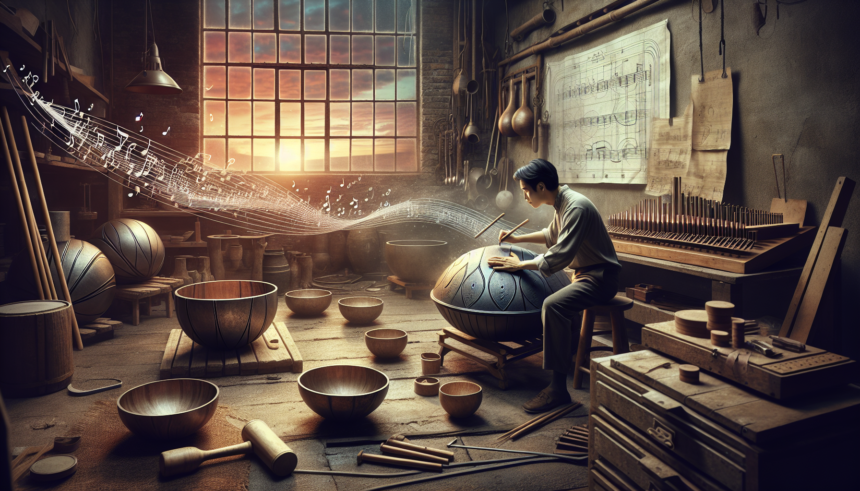<!DOCTYPE html>
<html lang="en">
<head>
<meta charset="UTF-8">
<meta name="viewport" content="width=device-width, initial-scale=1.0">
<title>Melodic Masterpieces: An Insight into Handpan Making</title>
</head>
<body>
<section>
<p>The handpan, an ethereal sounding instrument that has captivated the interest of music enthusiasts around the globe, is an artistic masterpiece both in design and sound. Born from the invention of the Hang in the early 2000s in Switzerland, the handpan has evolved into a symbol of innovative craftsmanship and melodic purity. This article explores the intricate process of handpan making, delving into the skill, artistry, and dedication required to create these harmonious instruments.</p>
<h2>The Origins of Handpan</h2>
<p>Created by Felix Rohner and Sabina Schärer of PANArt, the Hang was the first instrument of its kind, appearing in 2000. It was inspired by various traditional instruments like the steelpan, ghatam, and gamelan. Over time, the Hang gave rise to the handpan, an umbrella term for similar steel drum instruments produced by other manufacturers. Unlike the Hang, most modern handpans are made from nitrided steel, chosen for its combination of strength and tonal quality.</p>
<h2>Materials and Construction</h2>
<p>The crafting of a handpan begins with the careful selection of materials. The most commonly used material is nitrided steel, recognized for its ability to produce a wide range of tones and its durability. The steel sheets are hammered into a dome shape, often referred to as the 'shells'. The upper shell will feature a central note, known as the “Ding”, and seven or more additional note areas arranged in a circular pattern.</p>
<h2>The Art of Tuning</h2>
<p>Tuning a handpan is where the true artistry and skill of the maker is most clearly demonstrated. Each note area is painstakingly hammered to create an exact frequency that will blend with the others to produce harmonious scales. This process, called 'tuning', involves adjusting the tension and shape of the steel until the desired sound is achieved. The combination of shape, tension, and precision impacts the final audio quality, requiring both intuition and experience from the handpan maker.</p>
<h2>Design Variations and Innovations</h2>
<p>Modern handpan makers experiment with designs, scales, and tuning methods to create unique sonic palettes. Different handpans may have scales tailored to different musical genres or user preferences, and the arrangement of notes can vary significantly. Innovations such as integrated electronics for amplification or hybrid designs combining features from other instruments are pushing the boundaries of what handpans can achieve.</p>
<h2>Craftsmanship Challenges</h2>
<p>Creating a handpan is a meticulous and demanding process fraught with challenges. Each shell must be shaped with care and precision to ensure the instrument's integrity and tonal balance. Mistakes during shaping or tuning can result in a subpar instrument or necessitate starting the entire process anew. Many makers spend years refining their techniques and continue to evolve their craft.</p>
<h2>The Journey of a Handpan Maker</h2>
<p>For many handpan makers, producing these instruments is more than a craft; it is a passion and a pursuit of artistic expression. The community of makers is small and dedicated, often consisting of individuals who have apprenticed for years before mastering the trade. Many cite an emotional connection to the handpans they create, with each instrument being treated as a personal piece of art.</p>
<h2>Handpans and the Musical Community</h2>
<p>Handpans have had a significant impact on the global music community, popular in genres ranging from contemporary classical music to therapeutic sound sessions. Musicians appreciate the handpan for its versatility and the emotional depth it can convey. Handpan gatherings and festivals create spaces for enthusiasts to celebrate and share their commitment to this unique instrument.</p>
<h2>The Cultural and Therapeutic Influence</h2>
<p>Beyond music, handpans are often used in meditative practices and music therapy due to their calming and resonant sound. The instrument's ability to produce a melodious tone with minimal effort allows individuals, regardless of their musical background, to engage in mindful practice. This has expanded the handpan's role in cultural and therapeutic contexts, enhancing personal well-being through artistic expression.</p>
<h2>The Future of Handpan Manufacturing</h2>
<p>Handpan manufacturing continues to evolve as demand for these instruments grows. Advances in material science and engineering techniques regularly influence the creation process, while collaborative innovation among makers continues to push the limits of handpan design and sound. There is a focus on sustainability, ensuring that the craft remains environmentally conscious in its materials and methods.</p>
<h2>Conclusion</h2>
<p>The creation of handpans is an intricate blend of tradition, innovation, and pure artistry. Beyond being physical objects, these melodious instruments serve as bridges between cultures, individuals, and music itself. As new makers join the community and contribute to this evolving craft, the future of the handpan shines brightly, continuing to inspire and thrill audiences worldwide.</p>
<h2>FAQs</h2>
<ol>
<li>
<strong>What is a handpan made of?</strong>
<p>Most handpans are crafted from nitrided steel, which is prized for its durability and tonal properties. This material allows the handpan to produce a range of tones and sustain that is both resonant and long-lasting.</p>
</li>
<li>
<strong>Can anyone learn to play the handpan?</strong>
<p>Yes, the handpan is accessible to musicians of all skill levels. Its intuitive layout means that even beginners can create melodic music without extensive training.</p>
</li>
<li>
<strong>How long does it take to make a handpan?</strong>
<p>The time required to make a handpan can vary widely. An experienced maker might spend anywhere from several days to several weeks on a single instrument, depending on its complexity and customization.</p>
</li>
<li>
<strong>Why are handpans so expensive?</strong>
<p>Handpans are expensive due to the skilled labor, craftsmanship, and time involved in their creation. Each instrument is handcrafted with precision, requiring extensive material knowledge and expert tuning.</p>
</li>
<li>
<strong>How can one choose the right handpan?</strong>
<p>Choosing a handpan depends on personal preference regarding scale, sound, and design. It's advisable to try several options if possible, and seek guidance from experienced players or makers to find the right fit for your musical goals.</p>
</li>
</ol>
</section>
</body>
</html>Melodic Masterpieces: An Insight into Handpan Making

Leave a comment




